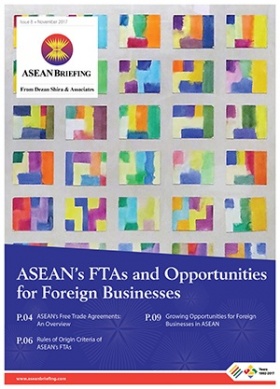Design Rights Protection in South East Asia
By: South-East Asia IPR SME Helpdesk
It is essential for SMEs doing business in South East Asia to protect their intellectual property rights, as poor IP strategy often leads to the end of the business endeavor in the region. Design rights are useful, but oftentimes overlooked means of protecting IP in South East Asia.
An industrial design right, also known as a design patent in certain jurisdictions, is an exclusive right, which protects designs which give a competitive edge to the owner over competitors due to their aesthetic appeal. Industrial designs can take the form of either two- or three-dimensional shapes, configuration or patterns. Prominent examples include the iPod, shape of the Coca Cola bottle, computer icons, and even the design of mobile applications.
To obtain industrial design protection, SMEs must file an application to register the design in all the countries they foresee business activities, since design rights like other IP rights are territorial. Like patents, protection for industrial rights lasts for a limited period and the duration can vary from country to country. Generally, protection lasts for at least 10 years.
Furthermore, industrial rights protection can be an asset to businesses. The success of a product or service is usually influenced by its visual appearance, where aesthetic appeal is one of the critical factors influencing consumer decisions. It is thus important for SMEs to draft a protection strategy matching the business strategy for the product or service in question.
Obtaining industrial design rights
To enjoy industrial design rights protection in South East Asian countries, design rights need to be registered first. Generally, in order to register a design, it must meet the following requirements:
- It must be novel;
- and it must be applied industrially.
Once a design is created, it must not be disclosed to preserve the novelty, since failing to do so, would expose EU SMEs to the risk that their design may then be considered as non-novel and its registration could be refused. If disclosure is necessary for business operations, it is recommended that SMEs enter into a Non-Disclosure Agreement (NDA) or an undertaking of confidentiality, which could preserve the novelty of their design. For instance, under Singapore law, disclosures of the design in breach of confidence will not destroy the novelty of the design. Similarly, in some South East Asian countries like Indonesia or Malaysia, for example, the novelty of a design shall not be lost if in a period of maximum six months before filing date if the design has been exhibited in an official exhibition (national or international) and/or has been used for education, research and development. EU SMEs should therefore consult local attorneys on the available mechanisms under the applicable laws to preserve novelty of the design if disclosure is unavoidable.
The procedure and process for an industrial design application differs between the ten ASEAN countries (Myanmar does currently not have a functioning system for obtaining design rights). Similarly, the costs of obtaining an industrial design in the various ASEAN countries can differ quite significantly, with the possibility of added translation costs for those countries (Indonesia, Thailand, Vietnam, for example) that only accept registrations in local languages. As English is not the working language of the agents in all the ASEAN countries, it is recommended that SMEs make prior enquiries with the local agents to determine if their working language is English.
It is important to conduct searches for existing industrial designs to ensure the novelty of a proposed design to be registered and to avoid any potential infringement of other’s design rights. It is crucial for businesses to be certain whether they have freedom to use their design without fear of infringement or whether a certain proposed design was still novel such as to be registered before incurring substantial investment costs. ASEAN Designview is the common online industrial design information platform of the ASEAN Member States aimed at making ASEAN industrial design data widely available and easily accessible to all interested stakeholders. ASEAN Designview offers free of charge online access to information on industrial design registrations and published industrial design applications in the participating ASEAN countries. It is thus recommended to consult ASEAN Designview prior to filing an industrial design rights application.
As IP Offices in most ASEAN countries generally only conduct a formal examination of the industrial design application, which pertains to whether the necessary documentation and details are provided, a substantive examination of the registration requirements, such as novelty and industrial application, is not undertaken. Consequently, it is often faster for industrial designs to be registered when compared to other IP applications such as patents or trade marks, barring any deficiencies in the required documents.
Business strategy
Industrial design rights allow the owner to commercially produce, market and sell his products. As industrial design rights are property rights, they can be assigned or licensed as appropriate to achieve better commercialization of the design.
Furthermore, SME’s IP strategy should not be limited to sole reliance on industrial design rights as a legal monopoly. As mentioned above, most ASEAN countries do not conduct substantive examinations, and thus rights granted by a registered design might be relatively uncertain. If an SME seeks to enforce their exclusive rights in the industrial design against another party, the other party will most likely challenge enforcement claiming the design does not satisfy the substantive requirements, for instance on the ground that the design is not novel.
Additionally, the interaction between industrial design rights and other IP rights such as copyright should be carefully considered. In some instances, designs which qualify for protection are also material where copyright subsists. In Singapore for example, where there is an overlap with copyright protection, there is no cumulative protection under registered design and copyright law, protection is available under registered designs only. Therefore, if the artistic work is a design suitable for registration, SMEs should take steps to apply to register the design, or there will be no protection for the design.
Concurrent protection under trade mark law is also a possibility as far as the protection of the shape and/or color is concerned. Those are considered unconventional trade marks and can be protected in most jurisdictions of South-East Asia, excluding Myanmar. If the industrial design is sufficiently distinctive of the proprietor’s products or services, it may be possible for him/her to also apply for a trade mark depending on the individual ASEAN countries’ laws. Unlike patents, copyright and industrial design rights, the duration of trade mark rights can be indefinite with sustained use as it is valid for 10 years and always renewable. EU SMEs should consider adding layered protection when possible to strengthen their design protection strategy.
 RELATED: IP Protection in the Philippines’ Food and Beverage Industry
RELATED: IP Protection in the Philippines’ Food and Beverage Industry
Enforcement
The owner of a registered industrial design has the right to exclude others from using or applying the design for commercial purposes. Depending on the specific legislation in the different ASEAN countries, other parties such as exclusive licensees can be granted the right to enforce this legal monopoly against third parties. For instance, an exclusive licensee can commence legal proceedings against unauthorized parties dealing with the design without needing the sanction of the registered owner.
There are several approaches to dealing with infringement of an industrial design right. In general, a cease and desist letter (C&D) can be issued as a show of force to the infringing party to demand a halt to the infringing activity. A C&D letter can also have the additional effect of giving due notice to the infringing party, which can have a material effect on the extent of damages awarded if the matter should proceed to litigation. If a C&D letter does not have the desired effect on the infringing party, more robust courses of action may have to be undertaken such as offering a license to the industrial design rights on one extreme and litigation on the other extreme. At the same time, in South East Asia mediation could be the most effective way of enforcing design rights.
In certain countries like Vietnam and Thailand, administrative actions are also possible cost-effective and time-efficient options, although they tend to be limited in effectiveness due to the relative inexperience of administrative bodies in dealing with more specialized areas such as industrial designs.
It should also be noted that in some countries like Singapore, Malaysia and Vietnam, an infringing party who has no knowledge or had no reasonable ground for believing that the design was registered, will not be liable for damages. An owner should thus consider applying the words “registered” or of similar meaning coupled with the registration number of the design to prevent infringing parties from escaping from the payment of damages.
About South-East Asia IPR SME Helpdesk
The South-East Asia IPR SME Helpdesk supports small and medium sized enterprises (SMEs) from European Union (EU) member states to protect and enforce their Intellectual Property Rights (IPR) in or relating to South-East Asian countries, through the provision of free information and services. The Helpdesk provides jargon-free, first-line, confidential advice on intellectual property and related issues, along with training events, materials and online resources. Individual SMEs and SME intermediaries can submit their IPR queries via email (question@southeastasia-iprhelpdesk.eu) and gain access to a panel of experts, in order to receive free and confidential first-line advice within 3 working days.
The South-East Asia IPR SME Helpdesk is co-funded by the European Union.
To learn more about the South-East Asia IPR SME Helpdesk and any aspect of intellectual property rights in South-East Asia, please visit our online portal at http://www.ipr-hub.eu/.
About Us
ASEAN Briefing is produced by Dezan Shira & Associates. The firm assists foreign investors throughout Asia and maintains offices throughout ASEAN, including in Singapore, Hanoi, Ho Chi Minh City and Jakarta. Please contact us at asia@dezshira.com or visit our website at www.dezshira.com.
- Previous Article Key Highlights of Cambodia-China Double Taxation Treaty
- Next Article Taxation in ASEAN: An Introduction






